Pass Shooting Coyotes
By Ty Pelfrey
©Copyright, Western Hunter Magazine
The formula is successful and simple: sneak in silently before sunrise, set-up and get comfortable, spot the dog, talk yourself through the shot and squeeze the trigger.
You may want to share this technique with trusted hunting partners that won't think you're crazy. On calm days and cool crystal clear mornings, tell your friends, "Leave the calls behind. Pass it along – let's pass shoot." I've hunted coyotes without the use of predator calls for the past four years, and there has been no shortage of shooting and plenty of success with this simple system.
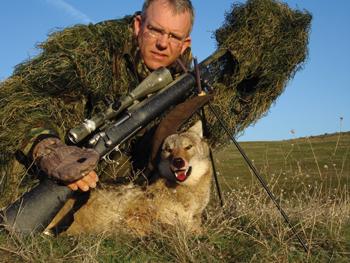
6:45 a.m. Here comes one straight at me – range 350 yards and closing – wait until he crosses the creek and trots to the top of the knoll. Easy now, no quick movements, just drop the rangefinder into your lap and frame the dog in the scope. There he is –twist up the scope to 20x power and get a good look. Now wait, wait, okay stop him with a quick raspy mouth bark, "Ruff!"… BANG!
After a crisp, clean shot in the early light of dawn, a hunter's first instinct is to go collect his pelt and inspect the prize, but I urge concealment – and don't move. After the shot, wait about thirty seconds, ease the rifle down and press your field glasses back into service. Scan the distant hills, skylines, swales, and every nook and cranny for another dog. Remain hidden and continue to hunt. Don't give yourself away to unseen coyotes that may be running at you because they don't know where danger lurks.
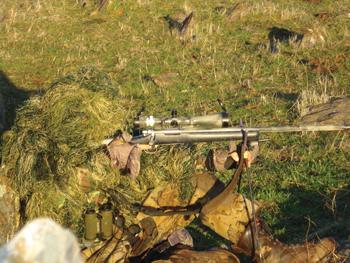
Coyotes are constantly cruising the country and are very active just before and after dawn. Every six minutes, one of those four-legged track stars covers a mile at what appears a simple trot – more aptly, a dog jog. Coyotes are returning from kill sites, chasing other dogs out of their territory, checking their country, or looking for mates, depending on the time of year. Those critters are crisscrossing the countryside following invisible scent trails and their instincts to defend their territory. Their desire to propagate and secure calories sends their shadowy forms across hundreds of acres a day.

It's a coyote's on-the-go lifestyle that a hunter should use to his advantage. A pass shooting hunter taps into these character traits with patience and planning. Take advantage of their wandering and cunning – let the coyotes do all the work while you relax and hunt. Consider this: it's a new hunt every six minutes, because the dog before you could have been over a mile away. There may be another dog behind that first one.
7:15 a.m. There's another one. Range him – 480 yards, trotting right to left. He may pass that rock outcropping at… let me see – 275 yards. Good! Twist a little, slowly push over the shooting sticks and lie down, put your rifle on your pack and line up on the rocks – there, much better. Back to the binoculars, now where is he? There you are, still on line, set the binoculars down – prop the rifle up – slowly. Excellent, just like it's supposed to go, put the cross hairs on the shoulder – steady – wait until he gets to the rock outcropping – WHAT was that flash that just blocked out the scope? Pick your head up and look over the rifle - coyote! Twenty yards - stop him – "Ruff!" Frozen in time, that's right, I'm over here somewhere – BANG! He's down, now back to the other dog, where did he go? There, standing on the outcropping – aim… BANG...
The cagey coyotes where I hunt are conditioned that predator calls equal rifle shots. I watched two hunters from a couple thousand yards one winter day from my favorite rock blind. Through my eight-power Swarovski's, the scene was crystal clear and I could have called the play-by-play before they ever blew their call.
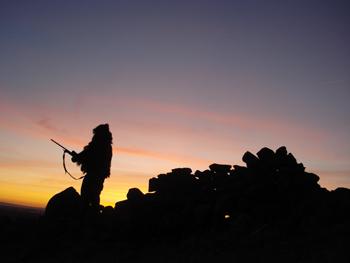
The coyote was about 600 yards out from them loping along, running into the wind, and checking the air. One of the hunters gave a great 10-second performance on a raspy rabbit call. The coyote was out of their field of vision, hidden by a small rolling hill. That coyote looked towards the hunters without seeing them, and ran directly away from their position, hitting Mach II before the next series of calls began. I watched from afar as their hunt went from prospective to unproductive due to a great call. Blowing a predator call is like sounding a warning bark in my neck of the woods.
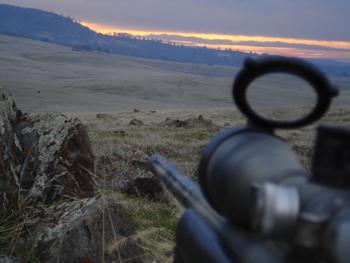
The time of the year can dramatically improve the shooting. Sure you'll pick-up an occasional young pup with a good predator calling technique in late summer, but for the most part, sitting silently and stealthy has proven very successful. I haven't killed a coyote using a call in over four years and seldom do I go hunting and not get a shot opportunity. One fateful January morning, 24 coyotes ran past my concealed sniper station, all within 800 yards – I actually ran out of ammunition! Another morning, I plowed three coyotes wirhin as many minutes running on what seemed the same invisible path on a frost covered morning. Each dog stopped in its tracks when I barked a loud, "Ruff!" with my mouth. They were all piled up within a 40- yard circle by the time I was done.
Quite frankly there are a lot of coyotes in the foothill belt of the Sierras. All a hunter really needs to do is have a little patience and do the necessary scouting for trails, and scat – using a locater howl before dawn doesn't hurt to boost moral if you're new to venturing out without a call.
Sometimes the hunt isn't one sided. I took my cousin, Reid, on his first coyote hunt a couple years ago. He fell asleep in the glow of morning and when he awoke he found a coyote standing on a rock twenty yards in front of him. He made the shot and the coyote fell into a ditch. Reid jumped in after the dog and poked it with a limp blade of grass to ensure the animal was dead. Seeing no reaction from the dog, Reid calculated he had successfully killed his first coyote. Waist deep in the ditch, Reid grabbed the dog by the scruff of the neck and above the tail and swung it back and forth a couple times to get enough momentum to heave the dog to level land while counting, "One, two …" and on three the coyote decided it would take a bite out of Reid. I guess the limp grass technique failed. Reid promptly recovered his rifle and dispatched the dog for good. The nimrod went to the emergency room, while the dog went to animal control for testing. A clean bill of former health was issued on the dog, and Reid's stitches were out in a couple weeks. The doctor asked Reid if the attack was provoked and Reid nodded in the affirmative.
7:16 a.m. I racked the bolt and peered at the outcropping through the 6.5-20x. I could see the dog running straight away from me – missed – I hurried the shot – can't do that! That's okay, there'll be another.
Comfort is important when sitting for a long time. I use an old pair of waders from the previous season's duck hunting. I cut the rubber boots off so my rear end stays warm and dry, and the small rocks and briars are no longer an issue. I use a balaclava, as it keeps my ears warm and covers my cheeks. Because I wear glasses, face covers can be a problem if my mouth and nose get covered - my glasses fog up in a hurry. I prefer mitten gloves, the type that allow the mitten portion to fold back, leaving all of the fingers free to dial binoculars and feel the trigger. I toss a little hand warmer in each mitten on cold mornings.
Concealment is made easier with great camouflage. A couple weeks ago I picked up an $80 Ghillie suit. I was a little afraid that I might be stepping into the fanatic stage of coyote hunting when I purchased the suit – until I saw a few pictures taken in the field. Wow, I'm sold on the Ghillie gear. I've only been wearing the top and hood, no need in my environment to put on the pants. When the Ghillie suit is used with my conventional camouflage, I nearly disappear on the prairie. Blending the outline of my body with rock outcroppings using various and blended camouflage patterns has helped keep me hidden from the cautious eye of the coyote, but fooling their nose is far more difficult. If they get downwind of me I'm usually busted.
The sun can be your friend on early morning hunts. I like to place my back to the sun, and since it's unpleasant to look directly into those early rays, I presume it's tough on the dogs too. Besides, the sun can reflect off your uncovered face or other gear, giving you away before your quarry is within range. Camo paint on your face or gear isn't a bad idea for the serious hunter.
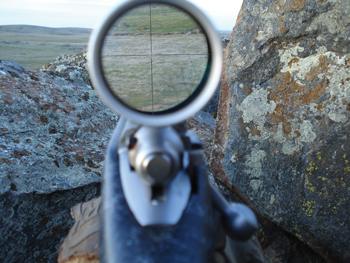
7:35 a.m. Another one! Range – 360 yards. Look at him, just standing there – where did he come from? Good, he's not looking, bring up the rifle. Dial up the scope and get a good look. He has no idea you are here so take your time. Push up the shooting sticks a bit, dial the scope up eight MOA, there, safety off, squeeze… BANG!
Last season, I used a couple cans of spray paint to color my stainless steel gun. I'm not sure that it has added to my success, but it was fun to do. Granted, painting up a thousand dollar gun was a bit unnerving, but after masking off the action and grabbing a handful of grasses and twigs from the yard to help with the camouflage patterning, I actually had a good time applying the spray paint. There are plenty of helpful hints on the Internet and military snipers have been painting their guns for years – so don't be bashful about finding your artistic side.
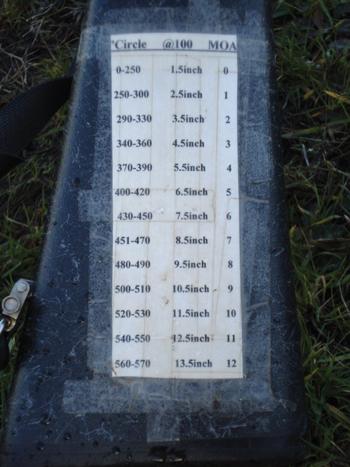
How fruitful and consistent is pass-shooting coyotes? I hunt on three square sections of land wedged against the foothills. I'll move my position around, not trying to hunt the same corner of each field on two consecutive days, and it seems to be enough to keep the coyote population wondering where I am silently lurking with my .22-250. The dogs' patterns are random, which makes this style of coyote chasing a hunt. I'll walk a half mile in the dark of the moon to set up, complete with a thermos of homemade, gourmet black coffee and a snack. I'll average a couple shots per two hour hunt, and usually bag two to three dogs per weekend - not a bad rate of pelt return for the energy investment. I can count on one hand the number of days I've been out in the past two years and not seen a coyote.
I'm still learning about long range coyote shooting. Ballistic calculators, chronographs and good factory ammunition have helped. I still get a little excited, which is good for the soul, but tough on shots out beyond 400 yards. Taping my MOA scope adjustments to my rifle has been helpful, but my forty-something eye sight makes close reading tough. I may be in the market for an adjustable scope with larger numbers on the turrets. Learning the wind is also an art I'm still trying to decipher.
There is plenty to learn and love about coyote hunting. Next time you go afield, consider a slow, stealthy stalk out to your favorite blind, strap in for a couple silent hours of pass shooting and see what happens. You may be pleasantly surprised.
By Ty Pelfrey
©Copyright, Western Hunter Magazine
The formula is successful and simple: sneak in silently before sunrise, set-up and get comfortable, spot the dog, talk yourself through the shot and squeeze the trigger.
You may want to share this technique with trusted hunting partners that won't think you're crazy. On calm days and cool crystal clear mornings, tell your friends, "Leave the calls behind. Pass it along – let's pass shoot." I've hunted coyotes without the use of predator calls for the past four years, and there has been no shortage of shooting and plenty of success with this simple system.

6:45 a.m. Here comes one straight at me – range 350 yards and closing – wait until he crosses the creek and trots to the top of the knoll. Easy now, no quick movements, just drop the rangefinder into your lap and frame the dog in the scope. There he is –twist up the scope to 20x power and get a good look. Now wait, wait, okay stop him with a quick raspy mouth bark, "Ruff!"… BANG!
After a crisp, clean shot in the early light of dawn, a hunter's first instinct is to go collect his pelt and inspect the prize, but I urge concealment – and don't move. After the shot, wait about thirty seconds, ease the rifle down and press your field glasses back into service. Scan the distant hills, skylines, swales, and every nook and cranny for another dog. Remain hidden and continue to hunt. Don't give yourself away to unseen coyotes that may be running at you because they don't know where danger lurks.

Coyotes are constantly cruising the country and are very active just before and after dawn. Every six minutes, one of those four-legged track stars covers a mile at what appears a simple trot – more aptly, a dog jog. Coyotes are returning from kill sites, chasing other dogs out of their territory, checking their country, or looking for mates, depending on the time of year. Those critters are crisscrossing the countryside following invisible scent trails and their instincts to defend their territory. Their desire to propagate and secure calories sends their shadowy forms across hundreds of acres a day.

It's a coyote's on-the-go lifestyle that a hunter should use to his advantage. A pass shooting hunter taps into these character traits with patience and planning. Take advantage of their wandering and cunning – let the coyotes do all the work while you relax and hunt. Consider this: it's a new hunt every six minutes, because the dog before you could have been over a mile away. There may be another dog behind that first one.
I hunt in wide-open country with short grass and can often glass coyotes from over a mile. They remind me of bees returning to a hive and for some reason, usually keep to a straight line headed for some distant destination. If the dog is headed in my direction, I have a good minute or two to slowly pick the yardages of different landmarks with my rangefinder and ease into a shooting position. However, I take caution to not become bemused and narrowly focus on one dog because other coyotes can seemingly appear while the one I'm watching will disappear. No wonder they are also known as the Spirit Dog.
7:15 a.m. There's another one. Range him – 480 yards, trotting right to left. He may pass that rock outcropping at… let me see – 275 yards. Good! Twist a little, slowly push over the shooting sticks and lie down, put your rifle on your pack and line up on the rocks – there, much better. Back to the binoculars, now where is he? There you are, still on line, set the binoculars down – prop the rifle up – slowly. Excellent, just like it's supposed to go, put the cross hairs on the shoulder – steady – wait until he gets to the rock outcropping – WHAT was that flash that just blocked out the scope? Pick your head up and look over the rifle - coyote! Twenty yards - stop him – "Ruff!" Frozen in time, that's right, I'm over here somewhere – BANG! He's down, now back to the other dog, where did he go? There, standing on the outcropping – aim… BANG...
The cagey coyotes where I hunt are conditioned that predator calls equal rifle shots. I watched two hunters from a couple thousand yards one winter day from my favorite rock blind. Through my eight-power Swarovski's, the scene was crystal clear and I could have called the play-by-play before they ever blew their call.

The coyote was about 600 yards out from them loping along, running into the wind, and checking the air. One of the hunters gave a great 10-second performance on a raspy rabbit call. The coyote was out of their field of vision, hidden by a small rolling hill. That coyote looked towards the hunters without seeing them, and ran directly away from their position, hitting Mach II before the next series of calls began. I watched from afar as their hunt went from prospective to unproductive due to a great call. Blowing a predator call is like sounding a warning bark in my neck of the woods.

The time of the year can dramatically improve the shooting. Sure you'll pick-up an occasional young pup with a good predator calling technique in late summer, but for the most part, sitting silently and stealthy has proven very successful. I haven't killed a coyote using a call in over four years and seldom do I go hunting and not get a shot opportunity. One fateful January morning, 24 coyotes ran past my concealed sniper station, all within 800 yards – I actually ran out of ammunition! Another morning, I plowed three coyotes wirhin as many minutes running on what seemed the same invisible path on a frost covered morning. Each dog stopped in its tracks when I barked a loud, "Ruff!" with my mouth. They were all piled up within a 40- yard circle by the time I was done.
Quite frankly there are a lot of coyotes in the foothill belt of the Sierras. All a hunter really needs to do is have a little patience and do the necessary scouting for trails, and scat – using a locater howl before dawn doesn't hurt to boost moral if you're new to venturing out without a call.
Sometimes the hunt isn't one sided. I took my cousin, Reid, on his first coyote hunt a couple years ago. He fell asleep in the glow of morning and when he awoke he found a coyote standing on a rock twenty yards in front of him. He made the shot and the coyote fell into a ditch. Reid jumped in after the dog and poked it with a limp blade of grass to ensure the animal was dead. Seeing no reaction from the dog, Reid calculated he had successfully killed his first coyote. Waist deep in the ditch, Reid grabbed the dog by the scruff of the neck and above the tail and swung it back and forth a couple times to get enough momentum to heave the dog to level land while counting, "One, two …" and on three the coyote decided it would take a bite out of Reid. I guess the limp grass technique failed. Reid promptly recovered his rifle and dispatched the dog for good. The nimrod went to the emergency room, while the dog went to animal control for testing. A clean bill of former health was issued on the dog, and Reid's stitches were out in a couple weeks. The doctor asked Reid if the attack was provoked and Reid nodded in the affirmative.
7:16 a.m. I racked the bolt and peered at the outcropping through the 6.5-20x. I could see the dog running straight away from me – missed – I hurried the shot – can't do that! That's okay, there'll be another.
Comfort is important when sitting for a long time. I use an old pair of waders from the previous season's duck hunting. I cut the rubber boots off so my rear end stays warm and dry, and the small rocks and briars are no longer an issue. I use a balaclava, as it keeps my ears warm and covers my cheeks. Because I wear glasses, face covers can be a problem if my mouth and nose get covered - my glasses fog up in a hurry. I prefer mitten gloves, the type that allow the mitten portion to fold back, leaving all of the fingers free to dial binoculars and feel the trigger. I toss a little hand warmer in each mitten on cold mornings.
Concealment is made easier with great camouflage. A couple weeks ago I picked up an $80 Ghillie suit. I was a little afraid that I might be stepping into the fanatic stage of coyote hunting when I purchased the suit – until I saw a few pictures taken in the field. Wow, I'm sold on the Ghillie gear. I've only been wearing the top and hood, no need in my environment to put on the pants. When the Ghillie suit is used with my conventional camouflage, I nearly disappear on the prairie. Blending the outline of my body with rock outcroppings using various and blended camouflage patterns has helped keep me hidden from the cautious eye of the coyote, but fooling their nose is far more difficult. If they get downwind of me I'm usually busted.
The sun can be your friend on early morning hunts. I like to place my back to the sun, and since it's unpleasant to look directly into those early rays, I presume it's tough on the dogs too. Besides, the sun can reflect off your uncovered face or other gear, giving you away before your quarry is within range. Camo paint on your face or gear isn't a bad idea for the serious hunter.

7:35 a.m. Another one! Range – 360 yards. Look at him, just standing there – where did he come from? Good, he's not looking, bring up the rifle. Dial up the scope and get a good look. He has no idea you are here so take your time. Push up the shooting sticks a bit, dial the scope up eight MOA, there, safety off, squeeze… BANG!
Last season, I used a couple cans of spray paint to color my stainless steel gun. I'm not sure that it has added to my success, but it was fun to do. Granted, painting up a thousand dollar gun was a bit unnerving, but after masking off the action and grabbing a handful of grasses and twigs from the yard to help with the camouflage patterning, I actually had a good time applying the spray paint. There are plenty of helpful hints on the Internet and military snipers have been painting their guns for years – so don't be bashful about finding your artistic side.

How fruitful and consistent is pass-shooting coyotes? I hunt on three square sections of land wedged against the foothills. I'll move my position around, not trying to hunt the same corner of each field on two consecutive days, and it seems to be enough to keep the coyote population wondering where I am silently lurking with my .22-250. The dogs' patterns are random, which makes this style of coyote chasing a hunt. I'll walk a half mile in the dark of the moon to set up, complete with a thermos of homemade, gourmet black coffee and a snack. I'll average a couple shots per two hour hunt, and usually bag two to three dogs per weekend - not a bad rate of pelt return for the energy investment. I can count on one hand the number of days I've been out in the past two years and not seen a coyote.
I'm still learning about long range coyote shooting. Ballistic calculators, chronographs and good factory ammunition have helped. I still get a little excited, which is good for the soul, but tough on shots out beyond 400 yards. Taping my MOA scope adjustments to my rifle has been helpful, but my forty-something eye sight makes close reading tough. I may be in the market for an adjustable scope with larger numbers on the turrets. Learning the wind is also an art I'm still trying to decipher.
There is plenty to learn and love about coyote hunting. Next time you go afield, consider a slow, stealthy stalk out to your favorite blind, strap in for a couple silent hours of pass shooting and see what happens. You may be pleasantly surprised.

